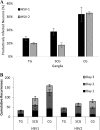Herpes Simplex Virus 1 Reactivates from Autonomic Ciliary Ganglia Independently from Sensory Trigeminal Ganglia To Cause Recurrent Ocular Disease
- PMID: 26041294
- PMCID: PMC4524238
- DOI: 10.1128/JVI.00468-15
Herpes Simplex Virus 1 Reactivates from Autonomic Ciliary Ganglia Independently from Sensory Trigeminal Ganglia To Cause Recurrent Ocular Disease
Abstract
Herpes simplex virus 1 (HSV-1) and HSV-2 establish latency in sensory and autonomic neurons after ocular or genital infection, but their recurrence patterns differ. HSV-1 reactivates from latency to cause recurrent orofacial disease, and while HSV-1 also causes genital lesions, HSV-2 recurs more efficiently in the genital region and rarely causes ocular disease. The mechanisms regulating these anatomical preferences are unclear. To determine whether differences in latent infection and reactivation in autonomic ganglia contribute to differences in HSV-1 and HSV-2 anatomical preferences for recurrent disease, we compared HSV-1 and HSV-2 clinical disease, acute and latent viral loads, and viral gene expression in sensory trigeminal and autonomic superior cervical and ciliary ganglia in a guinea pig ocular infection model. HSV-2 produced more severe acute disease, correlating with higher viral DNA loads in sensory and autonomic ganglia, as well as higher levels of thymidine kinase expression, a marker of productive infection, in autonomic ganglia. HSV-1 reactivated in ciliary ganglia, independently from trigeminal ganglia, to cause more frequent recurrent symptoms, while HSV-2 replicated simultaneously in autonomic and sensory ganglia to cause more persistent disease. While both HSV-1 and HSV-2 expressed the latency-associated transcript (LAT) in the trigeminal and superior cervical ganglia, only HSV-1 expressed LAT in ciliary ganglia, suggesting that HSV-2 is not reactivation competent or does not fully establish latency in ciliary ganglia. Thus, differences in replication and viral gene expression in autonomic ganglia may contribute to differences in HSV-1 and HSV-2 acute and recurrent clinical disease.
Figures





References
-
- Lafferty WE, Coombs RW, Benedetti J, Critchlow C, Corey L. 1987. Recurrences after oral and genital herpes simplex virus infection. Influence of site of infection and viral type. N Engl J Med 316:1444–1449. - PubMed
-
- Reeves WC, Corey L, Adams HG, Vontver LA, Holmes KK. 1981. Risk of recurrence after first episodes of genital herpes. Relation to HSV type and antibody response. N Engl J Med 305:315–319. - PubMed
Publication types
MeSH terms
Substances
Grants and funding
LinkOut - more resources
Full Text Sources
Medical
Research Materials

